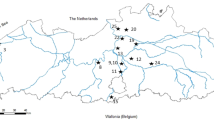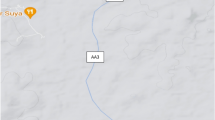Abstract
This investigation examines metal release from freshwater sediment using sequential extraction and single-step cold-acid leaching. The concentrations of Cd, Cr, Cu, Fe, Ni, Pb and Zn released using a standard 3-step sequential extraction (Rauret et al., 1999) are compared to those released using a 0.5 M HCl; leach. The results show that the three sediments behave in very different ways when subject to the same leaching experiments: the cold-acid extraction appears to remove higher relative concentrations of metals from the iron-rich sediment than from the other two sediments. Cold-acid extraction appears to be more effective at removing metals from sediments with crystalline iron oxides than the “reducible” step of the sequential extraction. The results show that a single-step acid leach can be just as effective as sequential extractions at removing metals from sediment and are a great deal less time-consuming.
Similar content being viewed by others
References
Alloway, B. J. (Ed.): 1995, Heavy Metals in Soils. Blackie Academic and Professional, London, pp. 368.
Agemian, H. and Chau, A. S. Y.: 1976, ‘Evaluation of extraction techniques for the determination of metals in aquatic sediments’, Analyst 101, 761–767.
Cave, M. and Wragg, J.: 1997, ‘Measurement of trace element distributions in soils and sediments using sequential leach data and a non-specific extraction scheme with chemometric data processing’, Analyst 22, 1211–1221.
Cooper, D. C. and Morse J. W.: 1998, ‘Extractability of metal sulfide minerals in acidic solutions: Application to environmental studies of trace metal contamination within anoxic sediments’, Environ. Sci. Technol. 32, 1076–1078.
Dodd, J. S.: 2000, An investigation of the geochemistry and petrology of canal sediments. Ph.D. Thesis. The University of Nottingham.
Hall, G. E. M., Vaive, J. E., Beer, R. and Hoashi, M.: 1996, ‘Selective leaches revisited, with emphasis on the amorphous Fe oxyhydroxide phase extraction’, J. Geochem. Expl. 56, 59–78.
Gambrell, R. P. and Patrick, Jr. W. H.: 1978, ‘Chemical and microbiological properties of anaerobic soils and sediments’, in: D. D. Hook and R. M. M. Craford (eds.), Plant Life in Anaerobic Environments, Ann Arbor, MI, pp. 375–423.
Lee, B.-G., Lee, J.-S., Luoma, S. N., Choi, H. J. and Koh, C.-H.: 2000, ‘Influence of acid-volatile sulfide and metal concentrations on metal bioavailability to marine invertebrates in contaminated sediments’, Environ. Sci. Technol. 34, 4517–4523.
Malo, B. A.: 1977, ‘Partial extraction of metals from aquatic sediments’, Environ. Sci. Technol. 11, 277–282.
O'Day, P. A., Carroll, S. A., Martinelli, R. E., Anderson, S. L., Jelinski, J. and Knezovich, J. P.: 2000, ‘Metal speciation and bioavailability in contaminated sediments, Alameda Naval Air Station, California’, Environ. Sci. Technol. 34, 3665–3673.
Peltier, E., Dahl, A. L. and Gaillard, J.-F.: 2005, ‘Metal speciation in anoxic sediments: When sulfides can be construed as oxides’, Environ. Sci. Technol. 39, 311–316.
Peterson, G. S., Ankley, G. and Leonard, E. N.: 1996, ‘Effect of bioturbation on metal-sulfide oxidation in surficial freshwater sediments’, Environ. Toxicol. Chem. 15(12), 2147–2155.
Rauret, G., Lopez-Sanchez, J. F., Sahuquillo, A., Rubio, R., Davidson, C., Ure, A. and Quevauviller, Ph.: 1999, ‘Improvement of the BCR three-step sequential extraction procedure prior to the certification of new sediment and soil reference materials’, J. Environ. Monit. 1, 57-61
Sahuquillo, A., Rigol, A. and Rauret, G.: 2003, ‘Overview of the use of leaching/extraction tests for risk assessment of trace metals in contaminated soils and sediments’, Trends Anal. Chem. 22, 152–159.
Stephens, S. R., Alloway, B. J., Parker, A., Carter, J. E. and Hodson, M. E.: 2001, ‘Changes in the leachability of metals from dredged canal sediments during drying and oxidation’, Environ. Pollut. 114/3, 407–413.
Sutherland, R. A.: 2002, ‘Comparison between non-residual Al, Co, Cu, Fe, Mn, Ni, Pb and Zn released by a three-step sequential extraction procedure and a dilute hydrochloric acid leach for soil and road-deposited sediment’, Appl. Geoch. 17, 353–365.
Tack, F. M. G. and Verloo, M. G.: 1995, ‘Chemical speciation and fractionation in soil and sediment analysis’, Intern. J. Environ. Anal. Chem. 59, 225–238.
Tack, F. M., Callewaert, O. W. J. J. and Verloo, M. G.: 1996, ‘Metal solubility as a function of pH in contaminated dredged sediment affected by oxidation’, Environ. Pollut. 91, 199–208.
Tessier, A., Campbell, P. G. C. and Bisson, M.: 1979, ‘Sequential extraction procedure for the speciation of particulate trace metals’, Anal. Chem. 51, 844.
U.S. EPA: 1995, An SAB report: Review of the Agency's approach for developing sediment criteria for five metals; EPS-SAB-EPEC-95-020; U.S. Environmental Protection Agency: Washington, DC.
U.S. EPA.: 1998, EPA's contaminated sediment management strategy; EPA-823-R-98-001; U.S. Environmental Protection Agency; Washington, DC.
Author information
Authors and Affiliations
Corresponding author
Rights and permissions
About this article
Cite this article
Cook, S.R., Parker, A. Sequential extraction and single-step cold-acid extraction: A feasibility study for use with freshwater-canal sediments. Water Air Soil Pollut 170, 95–105 (2006). https://doi.org/10.1007/s11270-006-2815-7
Received:
Accepted:
Published:
Issue Date:
DOI: https://doi.org/10.1007/s11270-006-2815-7




